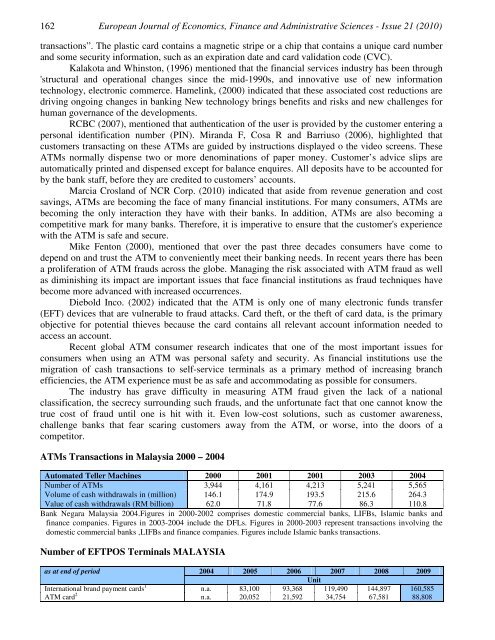ATM Risk Management and Controls - EuroJournals
ATM Risk Management and Controls - EuroJournals
ATM Risk Management and Controls - EuroJournals
Create successful ePaper yourself
Turn your PDF publications into a flip-book with our unique Google optimized e-Paper software.
162 European Journal of Economics, Finance <strong>and</strong> Administrative Sciences - Issue 21 (2010)<br />
transactions”. The plastic card contains a magnetic stripe or a chip that contains a unique card number<br />
<strong>and</strong> some security information, such as an expiration date <strong>and</strong> card validation code (CVC).<br />
Kalakota <strong>and</strong> Whinston, (1996) mentioned that the financial services industry has been through<br />
'structural <strong>and</strong> operational changes since the mid-1990s, <strong>and</strong> innovative use of new information<br />
technology, electronic commerce. Hamelink, (2000) indicated that these associated cost reductions are<br />
driving ongoing changes in banking New technology brings benefits <strong>and</strong> risks <strong>and</strong> new challenges for<br />
human governance of the developments.<br />
RCBC (2007), mentioned that authentication of the user is provided by the customer entering a<br />
personal identification number (PIN). Mir<strong>and</strong>a F, Cosa R <strong>and</strong> Barriuso (2006), highlighted that<br />
customers transacting on these <strong>ATM</strong>s are guided by instructions displayed o the video screens. These<br />
<strong>ATM</strong>s normally dispense two or more denominations of paper money. Customer’s advice slips are<br />
automatically printed <strong>and</strong> dispensed except for balance enquires. All deposits have to be accounted for<br />
by the bank staff, before they are credited to customers’ accounts.<br />
Marcia Crosl<strong>and</strong> of NCR Corp. (2010) indicated that aside from revenue generation <strong>and</strong> cost<br />
savings, <strong>ATM</strong>s are becoming the face of many financial institutions. For many consumers, <strong>ATM</strong>s are<br />
becoming the only interaction they have with their banks. In addition, <strong>ATM</strong>s are also becoming a<br />
competitive mark for many banks. Therefore, it is imperative to ensure that the customer's experience<br />
with the <strong>ATM</strong> is safe <strong>and</strong> secure.<br />
Mike Fenton (2000), mentioned that over the past three decades consumers have come to<br />
depend on <strong>and</strong> trust the <strong>ATM</strong> to conveniently meet their banking needs. In recent years there has been<br />
a proliferation of <strong>ATM</strong> frauds across the globe. Managing the risk associated with <strong>ATM</strong> fraud as well<br />
as diminishing its impact are important issues that face financial institutions as fraud techniques have<br />
become more advanced with increased occurrences.<br />
Diebold Inco. (2002) indicated that the <strong>ATM</strong> is only one of many electronic funds transfer<br />
(EFT) devices that are vulnerable to fraud attacks. Card theft, or the theft of card data, is the primary<br />
objective for potential thieves because the card contains all relevant account information needed to<br />
access an account.<br />
Recent global <strong>ATM</strong> consumer research indicates that one of the most important issues for<br />
consumers when using an <strong>ATM</strong> was personal safety <strong>and</strong> security. As financial institutions use the<br />
migration of cash transactions to self-service terminals as a primary method of increasing branch<br />
efficiencies, the <strong>ATM</strong> experience must be as safe <strong>and</strong> accommodating as possible for consumers.<br />
The industry has grave difficulty in measuring <strong>ATM</strong> fraud given the lack of a national<br />
classification, the secrecy surrounding such frauds, <strong>and</strong> the unfortunate fact that one cannot know the<br />
true cost of fraud until one is hit with it. Even low-cost solutions, such as customer awareness,<br />
challenge banks that fear scaring customers away from the <strong>ATM</strong>, or worse, into the doors of a<br />
competitor.<br />
<strong>ATM</strong>s Transactions in Malaysia 2000 – 2004<br />
Automated Teller Machines 2000 2001 2001 2003 2004<br />
Number of <strong>ATM</strong>s 3,944 4,161 4,213 5,241 5,565<br />
Volume of cash withdrawals in (million) 146.1 174.9 193.5 215.6 264.3<br />
Value of cash withdrawals (RM billion) 62.0 71.8 77.6 86.3 110.8<br />
Bank Negara Malaysia 2004.Figures in 2000-2002 comprises domestic commercial banks, LIFBs, Islamic banks <strong>and</strong><br />
finance companies. Figures in 2003-2004 include the DFLs. Figures in 2000-2003 represent transactions involving the<br />
domestic commercial banks ,LIFBs <strong>and</strong> finance companies. Figures include Islamic banks transactions.<br />
Number of EFTPOS Terminals MALAYSIA<br />
as at end of period 2004 2005 2006 2007 2008 2009<br />
Unit<br />
International br<strong>and</strong> payment cards 1 n.a. 83,100 93,368 119,490 144,897 160,585<br />
<strong>ATM</strong> card 2 n.a. 20,052 21,592 34,754 67,581 88,808

















